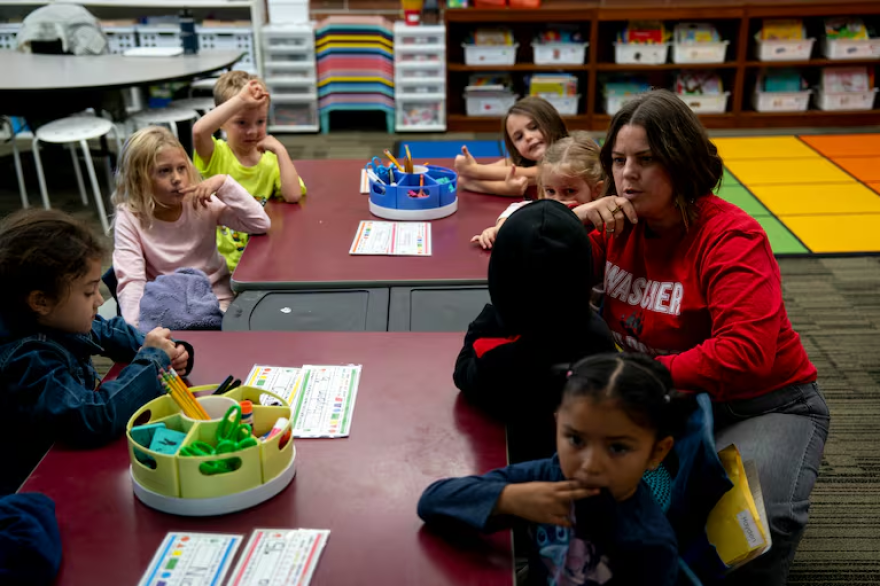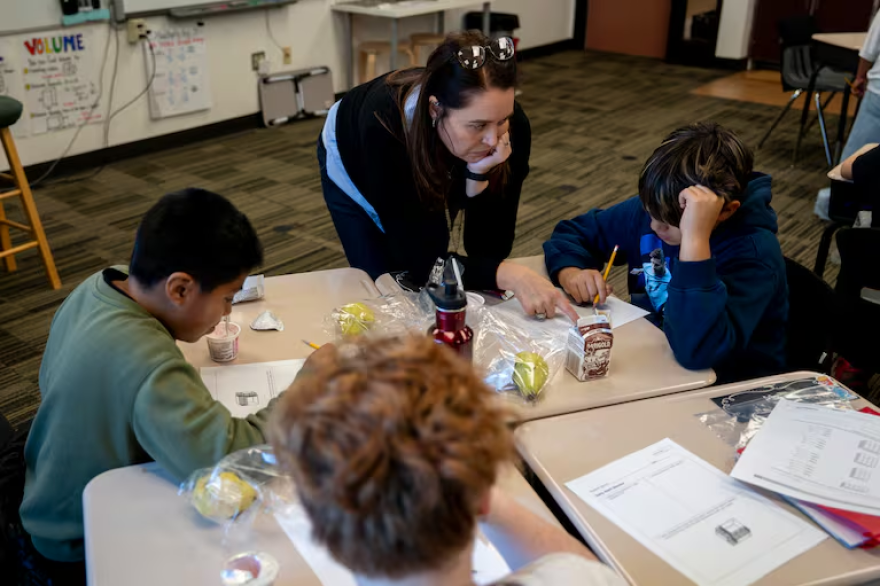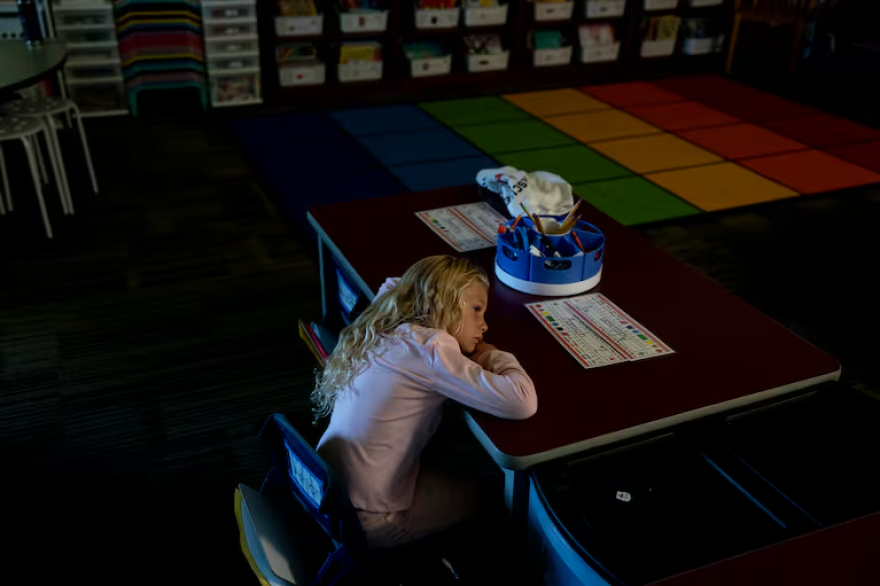On a recent October morning at Wascher Elementary School, Nicole “Nikki” Reynolds sang with her kindergarteners about the word of the day: responsibility.
Reynolds jumped and danced along with her students as a video played. “Responsibility is taking action and understanding the impact of our choices,” they sang. “So, let’s all raise our voices!”
When they sat back down, the McMinnville School District teacher encouraged her students to check in with themselves. Eyes are watching, ears are listening, voices are quiet and bodies are still. That’s responsible listening, she reminded them.
This is a social-emotional lesson in action. It’s the kind of experience that kids missed out on during the remote learning days of COVID-19.
“What if I just walk past the garbage on the ground?” Reynolds asked her students, posing a scenario where a person leaves litter on the sidewalk. “How’s that going to impact other people?” she asked.
“It would be bad,” one student said softly. Reynolds nodded.
“Remember, that book we read called, ‘What if everybody did that?’ Right? If everybody just threw garbage out the window and left it on the ground, what would our world look like?” Reynolds asked. “Would it be clean or would it be dirty?”
“Dirty,” the kinders said in unison.
“For sure,” Reynolds responded. “It’s recognizing how things we do can impact other people, right?”
Oregon leaders closed brick-and-mortar schools five years ago as the pandemic swept the planet. The switch to remote learning, as well as Oregon’s delayed return to in-person and hybrid classes, aimed to keep staff and students safe.
But these decisions also profoundly affected the academic and social-emotional wellbeing of hundreds of thousands of Oregon children.
The students who missed out on in-person kindergarten are now in fifth grade. And the kids born at the height of the pandemic are in kindergarten.
These two grades are crucial for families and educators when assessing whether kids are ready for the next educational chapter — elementary school for kindergarteners, middle school for fifth graders. And because of the pandemic, many students aren’t.
Attendance, standardized test scores and graduation rates show the pandemic’s ongoing effects on public schools in Oregon. And the growing use of technology, in part fueled by pandemic-era policies, has created a more isolated and less developed generation of students.
But there are pockets of success, often driven by schools and families taking specific steps.
Educators in McMinnville see hope.
McMinnville has seen greater recovery than Oregon as a whole. Recent data show that more McMinnville students graduate high school on time, attend school regularly and meet grade-level benchmarks in math and reading than their peers in other districts.
The mid-sized district in Oregon’s wine country had the advantage of stronger academic performance before the pandemic. But the district’s recent gains suggest paths to improvement for others.
With the right resources — including rigorous academic support, parent involvement and social-emotional lessons — McMinnville has been able to build back from the pandemic’s difficulties better than others.

Teaching during a global pandemic
Reynolds teaches kindergarten at Wascher Elementary in Lafayette. At the start of the pandemic, she taught in another local district.
Her students switched from full-day, in-person kindergarten to two and a half hours virtually, either in the morning or afternoon.
“It was a lot,” Reynolds said. “I mean, I still put on a show in front of the kids all day long, but it was a lot.”
Even though the school day was much shorter online, Reynolds said it was long for “their little brains to be on a screen.” It was also hard for her as a teacher. She couldn’t really tell who was and wasn’t learning.
“It was just hard on all of us,” she said.
Research in the last year has shown the deep impact remote learning had on K-12 students and the disproportionate harm it caused for the youngest kids. A recent study found that COVID-era school closures caused significant economic and educational loss, while being less effective in preventing the spread of the disease.
By the end of kindergarten, kids should be hitting certain benchmarks, such as knowing letters and sounds, recognizing simple words on a page and counting to 100.
They also need social skills and to understand basic classroom etiquette, like how to follow directions, raise their hands and stand in line.
National assessments have shown a decline in reading and math scores across the country, and even more sharply in Oregon. Elementary educators have also noticed developmental issues, such as more students starting school without knowing basic skills, like potty training.
Kourtney Ferrua, McMinnville’s interim superintendent, said it’s not just the pandemic that deeply impacted this generation of students — technology is another major factor.
Ferrua brought up “sandlot skills.” Children with less technology and more social interaction before starting school tend to be more imaginative, and they’ve already learned how to play with each other, how to share and how to resolve basic conflicts.
Distance learning inherently drove kids to more isolated environments. Ferrua said the combination of the pandemic and increased use of technology meant even after remote learning was done, kids started school far behind the expected development markers for their ages.
This often translates now into kids not knowing how to deal with difficult situations, how to handle failure or how to stick to a school schedule, Ferrua explained.
“School is really about being social,” she said, “and so, we need to teach those skills more explicitly than we did 10 years ago.”
While schools across the country grappled with remote learning, Oregon was unique as it was one of the last states to return in person. Advocates on various sides of the political spectrum have pointed to that as one of the reasons Oregon has been slower to recover academically.
Strict limitations on social distancing and school visitors also brought down parent engagement, Ferrua said, something districts now have to actively work to rebuild.
“Parents are their child’s first teacher, and they’re their most important teacher throughout their life,” she said. “How they feel about school really influences our students.”

Schools fight to recover after returning
When schools in Oregon slowly reopened in the spring of 2021, they operated differently.
Several classes remained online or hybrid, with some districts opening fully online schools. Inside school buildings, signs were posted to enforce social distancing, and front office sign-in requirements were tightened to help with contact tracing in the event of an outbreak.
Reynolds said it was a hard adjustment. They were still cramming kindergarten classes into half-day sessions, and the masks were especially hard for the younger kids. Plus, they couldn’t play on the playground.
“The only thing we could do to get exercise was to just, like, go run across the field, come back, just to move our bodies,” she said, “but they had to stay away from each other.”
One of the hardest adjustments coming back has been getting students to show up.
Chronic absenteeism — when students miss 10% or more school days a year — was a national issue before the pandemic. But it’s gotten worse.
An estimated 26% of public school students nationwide were considered chronically absent in the 2022-23 school year, up from 15% before the pandemic. In Oregon schools specifically, post-pandemic absenteeism shot up to about 38% that same year.
Though the McMinnville school district has a higher attendance rate than the statewide average today, it’s still struggling.
Prior to the pandemic, fewer than 10% of McMinnville students regularly missed school, according to the district. They haven’t returned to that level, with about 30% of students still chronically absent.
McMinnville, which currently enrolls about 6,200 students, is smaller and less economically or racially diverse than others, like Portland Public Schools or Salem-Keizer. For many districts without the same resources as McMinnville, post-COVID recovery has been even slower.
“Attendance is contagious, and it is pervasive,” Reynolds said. “Once you kind of get into a pattern of not thinking that school is a requirement every day, it’s really hard to break it. And I say it’s contagious in that if your friend group, or if the people around you, are chronically absent, it just makes it more acceptable to be also.”
Ferrua said it’s a message that everyone, not just schools, has to work on — that students should have a sense of belonging, that school is a fun place to be and that “learning feels great.”

Inside a classroom today
The kids who missed out on kindergarten at the height of COVID are now in their final year of elementary school.
Julie Schaffner’s fifth-grade class was working on their math review worksheets on an October morning at Wascher. They started in small groups and reviewed the answers they’d individually come up with, quickly erasing and marking their sheets as they bounced between their tablemates’ desks.
Schaffner would soon put the worksheet up on her projector and ask the students to walk her through each problem, gently correcting and demonstrating as they went.
“Raise your hand if you did this the long division way,” she asked her students as they worked together to divide 1,426 by 23. “OK. Put your hands down. Raise your hand if you did this using the area model. OK, put your hands down. Raise your hand if you did both. Wow. Nice job.”
Schaffner has taught in the McMinnville School District for 29 years, the vast majority of which have been at Wascher. She’s read reports of teachers nationwide dealing with a rise in social isolation and disruptive behaviors from students since the pandemic.
She’s seen some herself. But she said this year’s class is an anomaly.
“I feel like this group, they’re engaged in learning, and they actually want to be here, and they work really, really hard,” she said. “During the pandemic, the groups haven’t (all) been like that.”
Schaffner said she hasn’t had to fill in as many learning gaps for these students. This group is also more involved in activities outside of school and in their communities. “They’ve come in with this attitude of, ‘I can do this, and I can work hard,’ ” she said.
Schaffner thinks this cohort’s parents and guardians have been a key part of that success, seemingly more involved.
On a regular back-to-school night, Schaffner said she might get nine or 10 students’ parents to come. This year, 17 out of 20 showed up.
Many parents whose kids were in kindergarten at the start of the pandemic were especially worried about them missing out on in-person learning during a pivotal year, and it seems many worked hard to supplement that.
“They took it seriously,” Schaffner said.
Ferrua said a group of McMinnville parents read the 2024 book “The Anxious Generation: How the Great Rewiring of Childhood is Causing an Epidemic of Mental Illness” by Jonathan Haidt. The book is frequently cited as a catalyst for the current wave of school cellphone bans nationwide.
The McMinnville parents partnered with the district and local experts to host a series of parent nights to talk about the increase in anxiety among kids and the impacts of both technology and the pandemic.
Schaffner adapted her teaching style after learning more about technology during remote learning. She said school colleagues have been exceptionally supportive, too, including specialists who intervened with students who’d fallen furthest behind.
All of this helps her work with her students, so they’re ready for middle school — and everything that comes after that.
“I want them to be good humans,” Schaffner said. “I want them to treat each other nicely and to encourage each other. And I want them to try.”
What comes next?
Academic recovery is slow. New initiatives can take years to show effects, while funding and political momentum can be difficult to maintain amid competing local, state and federal priorities.
Meanwhile, many students and staff are still processing the trauma of the pandemic and figuring out how school should work now.
But there have been positive impacts of COVID-era decisions, too.
COVID highlighted inequities that had been facing schools for years and gave school leaders a push to better address students’ social and emotional needs, for example.
And now, national youth mental health stats are improving. Suicide rates for young people have gone down, and more students are reporting that they’re engaged with the world and finding joy.
“Educators throughout our system are working really hard,” Ferrua said. “You see it in classrooms every day, where they are leaning in with humanity … and holding high expectations.”
It’s because of those pockets of success that educators like Ferrua believe there is hope.
“This terrible thing happened to kids and teachers. And you know, all of us … will forever be changed by it,” she said. “But what we know about humans and brains is that they are always growing.”
This story comes to you from the Northwest News Network, a collaboration between public media organizations in Oregon and Washington.


